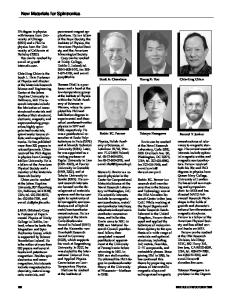The Ceramist as Chemist — Opportunities for New Materials
- PDF / 791,973 Bytes
- 12 Pages / 414.72 x 648 pts Page_size
- 32 Downloads / 882 Views
THE
CERAMIST AS CHEMIST - OPPORTUNITIES FOR NEW MATERIALS
D. R. UHLMANN, B.J.J. ZELINSKI AND G.E. WNEK, Department of Materials Science and Engineering, Massachusetts Institute of Technology, Cambridge, Mass. 02139
ABSTRACT
The use of sol-gel techniques to prepare glasses and crystalline ceramics offers outstanding opportunity for breakthroughs in technology. The areas of particular promise include novel glasses; crystallineceramics with exceptional microstructures; coatings for modification of electrical, optical, mechanical and chemical properties; porous media with high surface area and tailored chemistry; ceramic powders with high chemical homogeneity and narrow distributions of particle size; matrix materials in ceramicceramic composites; and a wide spectrum of specialty ceramic materials, ranging from abrasives and fibers to glass ceramics and films. Opportunities in each of these areas will be discussed and related to the advances in understanding and process technology required for their achievement. The theses will be advanced that creative chemistry provides the key to many of these advances, that ceramists simply 7UST learn more chemistry, but that we dare not rest from our labors when the chemistry is done.
I.
INTRODUCTION
The methods of wet chemistry offer outstanding promise for effecting radical changes in ceramics technology. The attendance at the present Symposium, like that at previous workshops held in Padua and Wurzburg, provides an effective commentary on the interest and even excitement which is characteristic of the field. Applications of the technology cover a broad front; and significant advances are announced on almost a monthly basis on developments ranging from varistors to optical waveguides. With all the richly-deserved attention directed to applications of sol-gel techniques, however, the underlying physics and chemistry has often been sadly neglected. Fundamental kinetic data are almost always unavailable; knowledge of structural features at various stages of processing is fragmentary at best; and the effects of process conditions on chemical species, reaction sequences and intermediate products remain to be explored in anything like satisfactory detail. The field thus seems to be constructing an edifice of ever-increasing splendor and complexity, but on foundations whose stilt-like character will soon compromise the overall structure. With this perspective, the present paper will first review some of the most attractive opportunities offered by sol-gel technology, as well as some of the most striking recent advances. It will then direct attention to a number of critical areas where our lack of knowledge of chemistry, structure and kinetics is already limiting our ability t6 synthesize desired materials. Finally, it will suggest the need of much greater interaction between ceramists and chemists, and the importance of educational changes in both disciplines to render easier such interaction.
Mat. Res. Soc. Symp.Proc. Vol. 32 (1984) Published by Elsevier science Publishing Co.
Data Loading...











